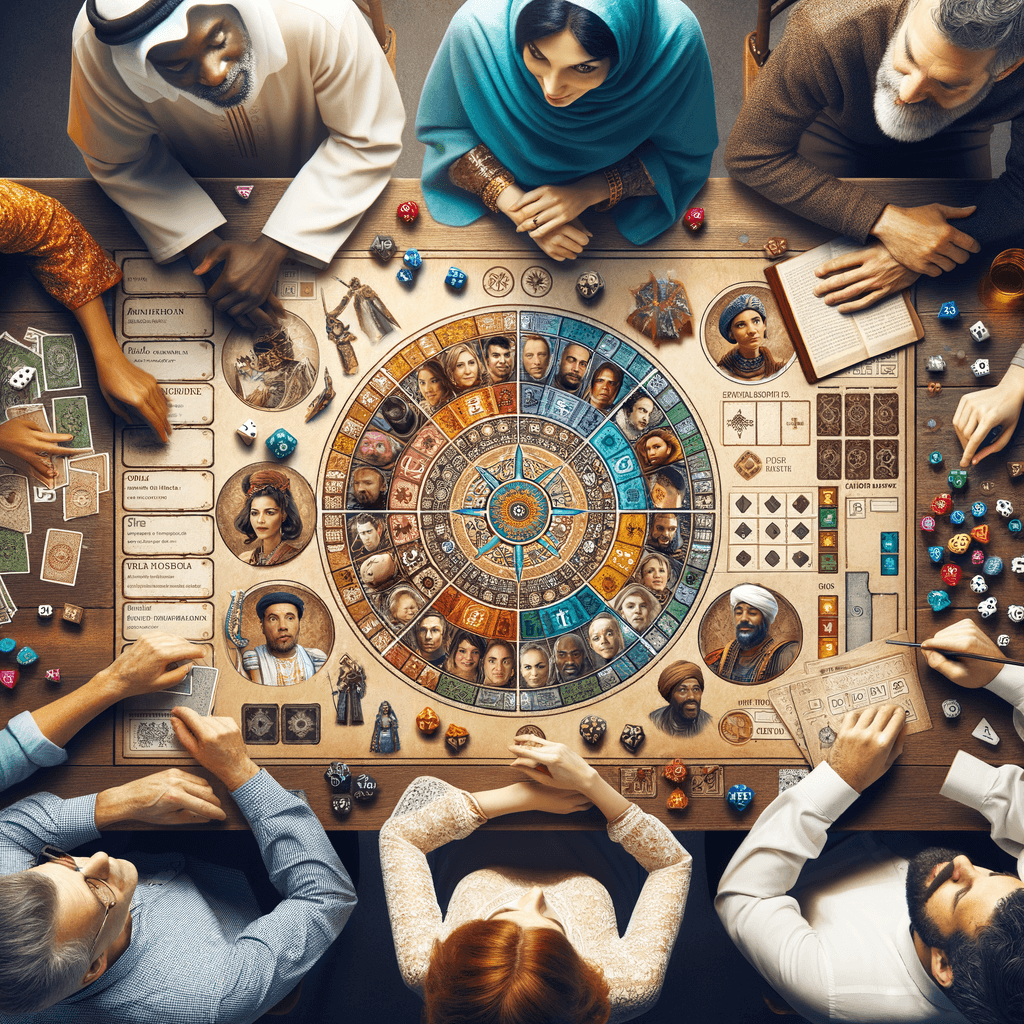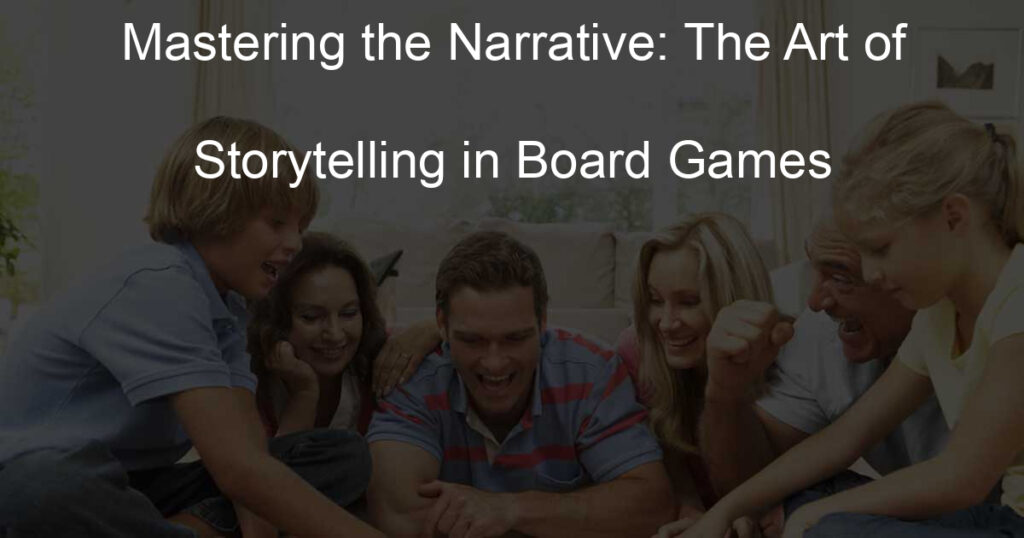Introduction to Board Game Storytelling
Hey there, board game enthusiasts! Ever wondered why some games just seem to pull you in more than others? Well, it’s all about the story. Let’s dive into the exciting world of narrative board games and see why storytelling is so important in these games. We’ll also look at some popular examples that you might want to try out!
-
- Definition of narrative board games
A narrative board game, also known as a storytelling board game, is a type of game where the story or theme plays a significant role. It’s not just about rolling the dice or moving pieces around a board. In these games, you might find yourself on a thrilling adventure, solving a mystery, or even creating your own story as you play. The game’s rules and mechanics are designed to help the story unfold. It’s like being in your own interactive book or movie! Wikipedia has a great article on this if you want to learn more.
-
- Importance of storytelling in games
Storytelling in games is super important because it makes the game more engaging and fun. It gives players a reason to care about what’s happening in the game. Instead of just trying to win, you’re also involved in a story that you want to see through to the end. Plus, a good story can make a game more memorable and unique. It’s the difference between playing a game and living an adventure!
-
- Examples of popular narrative board games
There are so many awesome narrative board games out there. Here are a few popular ones:
-
- Mansions of Madness: In this game, you’re a detective trying to solve a spooky mystery. The game even has an app that helps tell the story as you play!
- Pandemic Legacy: This is a cooperative game where you and your friends are trying to stop a global pandemic. The game changes each time you play, creating a unique story.
- Gloomhaven: This is a fantasy game where you’re an adventurer exploring a vast world. The game has a campaign mode that tells a long, epic story.
So, there you have it! Narrative board games are a fantastic way to combine the fun of playing a game with the excitement of a great story. Why not try one out and see for yourself?

Storytelling Techniques in Games
Let’s dive into one of the most exciting parts of game storytelling: creating immersive worlds. This is where the magic happens, folks!
Creating Immersive Worlds
Ever wondered what makes a game world feel real? It’s all about world-building, my friends. World-building is the process of creating an imaginary world that feels alive and believable. It’s like painting a picture, but instead of using brushes and colors, game designers use characters, settings, and stories.
Role of world-building in interactive storytelling games: World-building is the backbone of any good storytelling game. It sets the stage for the story and gives players a sense of place and purpose. It’s not just about creating a pretty backdrop; it’s about creating a world that players can interact with and influence. Think about games like “Minecraft” or “The Legend of Zelda”. These games have rich, detailed worlds that players can explore and change, making the gaming experience feel more personal and engaging.
Examples of immersive board games: There are plenty of board games out there that do an excellent job of world-building. “Pandemic Legacy”, for instance, creates a tense, high-stakes world where players must work together to stop a global pandemic. “Betrayal at House on the Hill” is another great example. In this game, players explore a haunted mansion, with the layout and spooky events changing each time you play. These games show that you don’t need fancy graphics or high-tech gadgets to create an immersive world. All you need is a good story and a little imagination.
So, next time you play a game, take a moment to appreciate the world around you. Remember, someone put a lot of thought and effort into creating that world, and it’s all for your enjoyment. Happy gaming!
Character Development
When we talk about board games, it’s not just about rolling dice and moving pieces. It’s also about the characters we play as. Let’s dive into the world of character development in board games!
-
- Importance of Character Depth in Board Game Design
Just like in a good book or movie, characters in board games need to be interesting and have depth. This makes the game more engaging and fun. When characters have their own unique abilities, strengths, and weaknesses, it adds a whole new level of strategy to the game. You need to think about how to best use your character’s abilities to win. This makes the game more than just a game of chance, it becomes a game of strategy and skill. According to a Wikipedia article on board game design, well-developed characters can greatly enhance the player’s immersion in the game’s world.
-
- Examples of Games with Strong Character Development
There are many games out there that have done an excellent job with character development. Let’s take a look at a few examples:
-
- “Pandemic Legacy” – In this game, players are disease-fighting specialists. Each character has unique abilities that can be upgraded as the game progresses. This adds a layer of depth and strategy to the game.
- “Gloomhaven” – This is a game of Euro-inspired tactical combat in a persistent world of shifting motives. Players will take on the role of a wandering adventurer with their own special set of skills and their own reasons for traveling to this dark corner of the world.
- “Betrayal at House on the Hill” – Each player chooses an explorer to investigate a creepy old house. As you explore the house, you discover new rooms. Each time you enter a new room, you might find something… or something might find you. Explorers change over the course of the game (for better or worse), depending on how they deal with the house’s surprises.
So, the next time you play a board game, take a moment to appreciate the characters. They’re a big part of what makes the game so much fun!
Role-Playing Board Games
Hey there, board game enthusiasts! Today, we’re diving into the exciting world of role-playing board games. These games are not just about rolling dice and moving pieces around a board. They’re about stepping into a new character’s shoes and living out their adventures. Let’s get started!
Understanding Role-Playing Mechanics
Before we delve deeper, let’s understand what role-playing in board games means and how it enhances storytelling.
-
- Definition of role-playing in board games
Role-playing in board games is all about taking on the persona of a character in the game. You’re not just a player; you’re a brave knight, a cunning detective, or a powerful wizard. Your decisions, actions, and even your conversations are guided by your character’s personality and objectives. It’s like being in a play, where the script is written as you go along!
-
- How role-playing enhances storytelling
Role-playing takes storytelling in board games to a whole new level. Instead of just following a set storyline, you get to create your own. Your character’s actions and decisions shape the story, making every game unique. It’s a fantastic way to immerse yourself in the game’s world and really feel like part of the story.
Role-playing board games offer a unique blend of strategy, creativity, and storytelling. They allow us to step into different roles and experience different adventures, all while sitting around a table with friends. So, grab a game, pick a character, and let the adventure begin!
Top Role-Playing Board Games
Hey there, board game enthusiasts! Let’s dive into some of the most popular role-playing board games that have captured our hearts and imaginations. We’ll also take a closer look at their storytelling techniques, and see what makes them so engaging.
-
- Examples of Popular Role-Playing Board Games
There are countless role-playing board games out there, but some have truly stood the test of time. Here are a few fan favorites:
-
-
- Dungeons & Dragons: This classic game has been a staple in the role-playing genre for decades. It’s all about creating your own character and embarking on epic adventures.
- Gloomhaven: A cooperative game of tactical combat in a unique, evolving fantasy world. Each player will take on the role of a wandering adventurer with their own special set of skills.
- Pandemic Legacy: In this thrilling game, players work together to stop deadly diseases from spreading across the globe. The game evolves as you play, making each game unique.
- Analysis of Their Storytelling Techniques
-
What makes these games so captivating? Let’s break it down:
-
- Character Development: In games like Dungeons & Dragons, players get to create and develop their own characters. This personal connection makes the story more engaging.
- Cooperative Gameplay: Games like Gloomhaven and Pandemic Legacy require players to work together to achieve a common goal. This shared experience can make the story more immersive.
- Evolutionary Gameplay: In games like Pandemic Legacy, the game changes each time you play. This dynamic storytelling keeps players on their toes and makes each game a new adventure.
So, there you have it! Some of the top role-playing board games and a peek into their storytelling magic. Whether you’re a seasoned gamer or new to the scene, these games offer a fantastic way to dive into the world of role-playing board games. Happy gaming!
Narrative in Game Design
Hey there, game enthusiasts! Today, we’re going to dive into the exciting world of narrative in game design. We’ll explore how to integrate story into game mechanics, making your gaming experience even more immersive and engaging. So, let’s get started!
Integrating Story into Game Mechanics
When it comes to game design, integrating story into game mechanics is like mixing peanut butter and jelly – it’s a match made in heaven! But how do we do it seamlessly? Let’s find out.
-
- How to seamlessly blend story and gameplay
First off, it’s all about balance. The story and gameplay should complement each other, not compete. Think of it as a dance, where each element takes turns leading. The gameplay can set the pace, while the story adds depth and emotion. For instance, in a mystery game, the gameplay could involve finding clues, while the story unfolds as players solve the puzzle.
-
- Examples of games with integrated narrative mechanics
Now, let’s look at some examples of games that have nailed this integration. Ever heard of “The Witcher 3: Wild Hunt”? In this game, every action you take impacts the story, making you feel like you’re truly part of the narrative. Another great example is “Bioshock”, where the story is revealed through gameplay, creating a deeply immersive experience.
So, that’s the scoop on integrating story into game mechanics. Remember, it’s all about balance and making sure the gameplay and story work together to create an unforgettable gaming experience. Happy gaming!
Challenges in Narrative Game Design
Designing a board game with a strong narrative is no easy task. There are many challenges that game designers face when trying to weave a compelling story into the mechanics of a game. Let’s take a look at some of these hurdles and how to overcome them.
-
- Common pitfalls in board game storytelling
One of the biggest challenges in narrative game design is balancing the story with the gameplay. Too much story can overwhelm the game mechanics, while too little can leave players feeling disconnected from the game. It’s a tricky tightrope to walk!
Another common pitfall is creating a story that doesn’t engage the players. A good narrative game should make players feel like they’re part of the story, not just observers. This requires careful crafting of characters, plot, and game mechanics to ensure that players are invested in the outcome.
Finally, many designers struggle with maintaining narrative consistency throughout the game. This means making sure that the story makes sense from beginning to end, and that the actions players take in the game align with the narrative.
-
- How to overcome these challenges
So, how can you overcome these challenges in narrative game design? Here are a few tips:
-
- Balance is key. Try to find the sweet spot between story and gameplay. This might involve some trial and error, but it’s worth it in the end.
- Engage your players. Make them feel like they’re part of the story. This can be achieved through character development, plot twists, and game mechanics that allow players to influence the story.
- Maintain narrative consistency. Make sure your story makes sense from beginning to end, and that player actions align with the narrative. This might require some careful planning and a lot of playtesting, but it’s crucial for a successful narrative game.
Designing a narrative board game can be a challenging task, but with careful planning and a lot of creativity, it’s definitely achievable. So, don’t be afraid to take the plunge and create your own narrative board game masterpiece!
Storytelling in Tabletop Games
Hey there, game lovers! Today, we’re going to dive into the magical world of tabletop games and their unique storytelling aspects. So, grab your dice, and let’s get started!
Unique Aspects of Tabletop Storytelling
Tabletop games are a whole different ball game when it comes to storytelling. They have a unique charm that sets them apart from digital games. Let’s explore how.
-
- How tabletop games differ from digital games in storytelling
Tabletop games are all about imagination and creativity. Unlike digital games, where the graphics and animations do most of the work, tabletop games rely on the players’ minds to bring the story to life. The narrative is often shaped by the players’ decisions, making each game a unique experience. Plus, the social aspect of sitting around a table with friends adds a personal touch to the storytelling process. It’s like being part of a live, interactive storybook!
-
- Advantages of tabletop games for storytelling
Tabletop games offer a lot of advantages when it comes to storytelling. First, they allow for a high level of player involvement. You’re not just a passive observer; you’re an active participant shaping the story. Second, they promote social interaction. Nothing beats the fun of gathering around a table with friends, sharing laughs, and creating memories. Lastly, they foster creativity and imagination. With tabletop games, the sky’s the limit!
So, next time you’re looking for a fun and engaging way to tell a story, why not give tabletop games a try? You might be surprised at how much fun you can have while crafting your own unique narrative. Happy gaming!
Case Study: Dungeons & Dragons
Let’s dive into a fantastic example of storytelling in tabletop games: Dungeons & Dragons. This game has not only revolutionized the world of tabletop games but also set a new standard for storytelling.
- How Dungeons & Dragons Revolutionized Storytelling in Tabletop Games
Before Dungeons & Dragons, or D&D as it’s often called, most board games were about winning or losing. But D&D changed all that. It introduced a whole new concept: the game was not just about winning, but about telling a story together. D&D gave players the chance to step into the shoes of their characters and live out their adventures.
One of the key elements that made D&D so revolutionary was its focus on character development. In D&D, your character grows and changes as the game progresses. This was a big shift from traditional board games where your pieces remained the same from start to finish.
- Key Takeaways from Its Success
So, what can we learn from the success of D&D? Here are a few key takeaways:
- Storytelling is powerful: D&D showed us that games can be about more than just winning or losing. They can be about telling a story together.
- Character development matters: In D&D, characters grow and change as the game progresses. This makes players feel more connected to the game.
- Imagination is key: D&D relies heavily on the players’ imaginations. This makes the game more engaging and fun.
In conclusion, Dungeons & Dragons revolutionized the world of tabletop games by introducing a new way of storytelling. It showed us that games can be about more than just winning or losing – they can be about telling a story together. And that’s a lesson we can all take to heart.
Conclusion: The Future of Board Game Storytelling
As we journey through the magical world of board game storytelling, it’s exciting to think about what the future holds. Let’s take a peek at the current trends and make some predictions for the future of this captivating form of entertainment.
-
- Current trends in narrative board games
Today, we’re seeing a surge in the popularity of narrative board games. They’re not just about rolling dice and moving pieces anymore. Players are now part of immersive stories, with choices that impact the game’s outcome. Games like Gloomhaven and Pandemic Legacy are perfect examples of this trend, offering rich narratives that evolve with each play.
-
- Predictions for the future of board game storytelling
Looking ahead, we can expect even more innovation in board game storytelling. With advancements in technology, we might see games that combine physical components with digital elements for a more interactive experience. Imagine a game where your smartphone acts as a personal game master, guiding you through the story and adapting it based on your decisions. The possibilities are endless!
In conclusion, the future of board game storytelling is bright and full of potential. As game designers continue to push the boundaries of what’s possible, players can look forward to even more immersive and engaging narrative experiences. So, grab a game, gather your friends, and let the storytelling begin!



